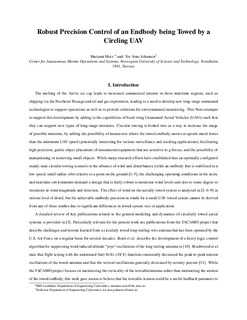Control of an End Body Towed by a Circling Unmanned Aerial Vehicle
Journal article, Peer reviewed
Accepted version

Åpne
Permanent lenke
http://hdl.handle.net/11250/2630234Utgivelsesdato
2019Metadata
Vis full innførselSamlinger
Originalversjon
10.2514/1.G004199Sammendrag
The melting of the Arctic ice cap leads to increased commercial interest in these maritime regions, such as shipping via the Northeast Passage and oil and gas exploration, leading to a need to develop new long-range unmanned technologies to support operations as well as to provide solutions for environmental monitoring. This Note attempts to support this development by adding to the capabilities of fixed-wing unmanned aerial vehicles (UAVs) such that they can support new types of long-range missions. Circular towing, where a cable with an attached end body is towed behind a UAV that tracks a circular path, is looked into as a way to facilitate high-precision gentle object placement of instruments/equipment that are sensitive to gravity forces, and potentially to manipulate or retrieve small objects. Furthermore, the method may be used for missions that require the towed end body to move at speeds much lower than the minimum UAV speed (potentially interesting for various surveillance and tracking applications). Although many research efforts have established that an optimally configured steady-state circular-towing scenario in the absence of wind and disturbances yields an end body that is stabilized in a low-speed small radius orbit relative to a point on the ground [1–5], the challenging operating conditions in the Arctic and maritime environments demand a design that is robust to moderate wind levels and to gradual variations in wind magnitude and direction. The effect of wind on the aerially towed system was analyzed in Refs. [3,6–9] in various levels of detail, but the achievable end body precision in winds for a small UAV towed system cannot be derived from any of these studies due to significant differences in towed system size or application.